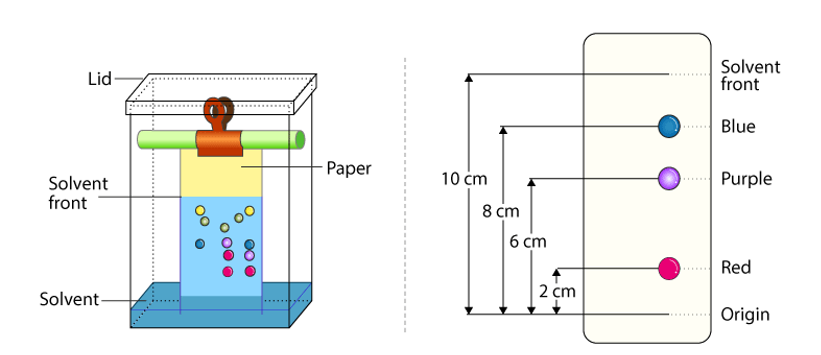Introduction
Paper chromatography is a simple and effective analytical technique used to separate and identify mixtures of substances. This method is classified under partition chromatography, where separation occurs based on the differential partitioning of solutes between a mobile phase (solvent) and a stationary phase (paper). It was first introduced in the early 20th century and has since become a foundational tool in analytical chemistry.
The technique is widely used for qualitative analysis in areas such as biochemistry, pharmacology, and environmental science. It is particularly effective for separating and identifying small molecules like amino acids, sugars, and pigments.
Methodology of Paper chromatography
Paper chromatography involves the following key steps:
1. Selection of Paper:
Chromatography paper (Whatman No. 1 or similar) serves as the stationary phase. The paper is composed of cellulose, which adsorbs water and creates a thin layer acting as the stationary phase.
2. Preparation of Sample:
The mixture to be separated is dissolved in a suitable solvent to prepare a sample solution. A small volume of this solution (usually a drop) is applied onto the paper at a specific point, called the origin.

3. Choice of Solvent:
The mobile phase is chosen based on the nature of the components in the mixture. Common solvents include water, alcohol, acetone, and mixtures like water-ethanol.
4. Development of Chromatogram:
The chromatographic paper is suspended in a chamber containing the mobile phase. The solvent travels up the paper via capillary action, carrying the sample components.
5. Drying and Visualization:
After the solvent front reaches a predetermined height, the paper is removed and dried. Visualization of separated components is achieved using techniques like: UV light exposure. Spraying with reagents (e.g., ninhydrin for amino acids).
6. Interpretation:
Retention factor (Rf) values are calculated for each separated component:

Development Techniques of Paper chromatography
There are several techniques for developing a chromatogram based on how the solvent moves through the paper:
1. Ascending Development:
The lower edge of the paper is dipped into the solvent, and the solvent travels upward.
2. Descending Development:
The solvent flows downward due to gravity, providing better separation for some mixtures.
3. Radial (Circular) Development:
The sample is placed at the center of circular paper. The solvent moves outward in a radial fashion.
4. Two-Dimensional Development:
After the first run, the paper is rotated 90°, and a second run is performed using a different solvent to achieve enhanced separation.
Advantages of Paper chromatography
1. Simple and Inexpensive: Requires minimal equipment and is cost-effective.
2. Versatility: Suitable for a wide range of analytes.
3. Small Sample Requirement: Requires only microgram levels of the sample.
4. No Complex Equipment: Operates without the need for advanced instrumentation.
5. Portable: Can be performed in field studies.
Disadvantages of Paper chromatography
1. Limited Sensitivity: Cannot detect components present in trace amounts.
2. Time-Consuming: The process is slower compared to modern chromatographic techniques.
3. Resolution Issues: Poor separation of closely related compounds.
4. Irreproducibility: Results can vary due to environmental factors like temperature and humidity.
5. Not Suitable for Volatile Substances: Inefficient for analyzing volatile or highly hydrophobic compounds.
Applications of Paper chromatography
1. Biochemistry: Separation and identification of amino acids, sugars, and nucleotides.
2. Pharmaceutical Analysis: Detection of impurities in drugs and active pharmaceutical ingredients (APIs).
3. Food Industry: Analysis of food colors, additives, and contaminants.
4. Environmental Science: Monitoring pollutants and separating pigments in plant extracts.
5. Forensic Science: Analysis of inks, dyes, and other trace evidence in crime investigations.
6. Education and Research: Widely used for teaching basic chromatographic principles in labs.
Paper chromatography is a fundamental analytical technique, especially for educational purposes and preliminary qualitative analysis. Despite its limitations, it remains valuable in resource-limited settings and specific applications due to its simplicity and effectiveness. Its principles form the foundation for more advanced chromatographic techniques, such as thin-layer and high-performance liquid chromatography.

